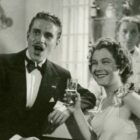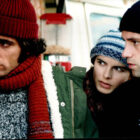In the tapestry of filmmaking, two elements often stand out as powerful storytellers in their own right: location and music. These components, when skillfully woven together, transcend mere background elements and become pivotal to the narrative, mood, and emotional depth of a film. This dynamic interplay can be likened to a conversation where each element enhances and elevates the other, creating a more immersive and impactful cinematic experience.
Locations: Setting the Stage
Locations in films are more than just backdrops; they are characters that contribute significantly to the story. They provide context, evoke emotions, and influence the behavior and fate of the characters. A location can symbolize the internal state of a character or reflect the thematic essence of the narrative. For instance, the bustling yet intimate streets of Rome in Vittorio De Sica’s “Peccato che sia una canaglia” (Too Bad She’s Bad) set the stage for a tale of charm, deceit, and romance, enhancing the film’s light-hearted yet poignant mood.
Music: The Emotional Narrator
Music, on the other hand, serves as the emotional undercurrent of a film. It has the unique ability to convey the subtext and emotional nuances that dialogue and visuals alone might not fully express. A well-chosen score can heighten tension, evoke nostalgia, or underscore the poignancy of a scene. In Pier Paolo Pasolini’s “La Rabbia” (The Anger), the stirring classical music juxtaposes the harsh realities depicted in the film, adding a layer of emotional depth and reflective melancholy.
Cinematic Conversations
When locations and music converse in film, they create a synergistic effect that enriches the storytelling. This conversation can be seen in the works of renowned Italian filmmakers like Vittorio De Sica, Pier Paolo Pasolini, and Michelangelo Antonioni.
Vittorio De Sica: “Peccato che sia una canaglia”
In “Peccato che sia una canaglia,” the vibrant cityscape of Rome plays a crucial role. The city’s charm and chaos are beautifully captured, and Alessandro Cicognini’s whimsical score complements this backdrop perfectly. The lively, bustling streets mirror the playful and unpredictable romance between Nando and Lina, while the music enhances the comedic and romantic tones, creating a light-hearted yet emotionally resonant narrative.
Pier Paolo Pasolini: “La Rabbia”
In Pasolini’s “La Rabbia,” the stark, powerful imagery of various locations combined with the evocative classical music creates a profound commentary on societal issues. The desolate landscapes and urban decay depicted in the film are underscored by a melancholic yet powerful score. This interplay of music and location amplifies the film’s themes of anger, despair, and the search for hope, providing a visceral, emotional experience for the audience.
Michelangelo Antonioni: “La Notte”
Antonioni’s “La Notte” presents a masterful conversation between the urban environment of Milan and the minimalist, haunting score by Giorgio Gaslini. The sleek, modern architecture and the night-time cityscapes reflect the emotional emptiness and alienation experienced by the characters. The music, often sparse and reflective, underscores their existential angst. This dialogue between location and music creates an atmosphere of introspection and disquiet, compelling the audience to delve into the psychological depths of the characters.
The Importance in Film
The interaction between locations and music is crucial in film as it can profoundly shape the viewer’s experience. This interplay:
- Enhances Atmosphere: The synergy between setting and score can create a vivid, immersive world that draws the audience into the film’s reality.
- Amplifies Emotions: Music can highlight the emotional landscape of a scene, while locations can provide a tangible context, making the emotions more palpable.
- Deepens Narrative: The combination of visual and auditory elements can add layers of meaning to the story, offering insights into the characters and themes that might not be immediately apparent through dialogue alone.
- Creates Memorable Moments: Iconic scenes often owe their impact to the perfect marriage of location and music, creating moments that linger in the audience’s memory long after the film ends.
In conclusion, the conversation between locations and music in film is a powerful tool that, when skillfully orchestrated, can elevate a film from mere entertainment to an art form that resonates deeply with its audience. The works of De Sica, Pasolini, and Antonioni stand as testament to the enduring power of this dynamic interplay, demonstrating how location and music can work together to create profound and lasting cinematic experiences.
Watch these movies and many more on Movieitaly+
Read more facts here!






